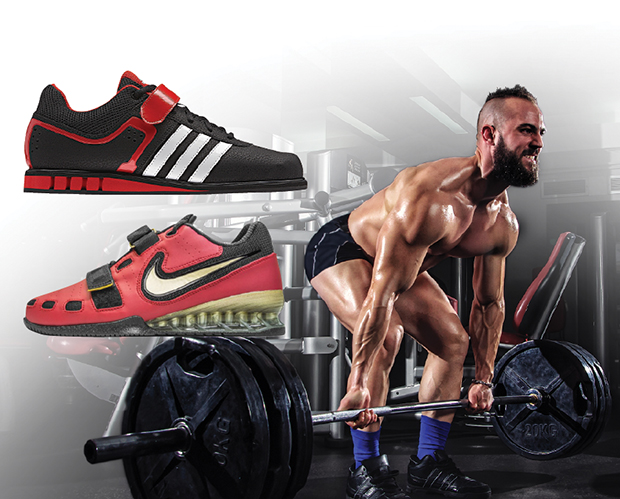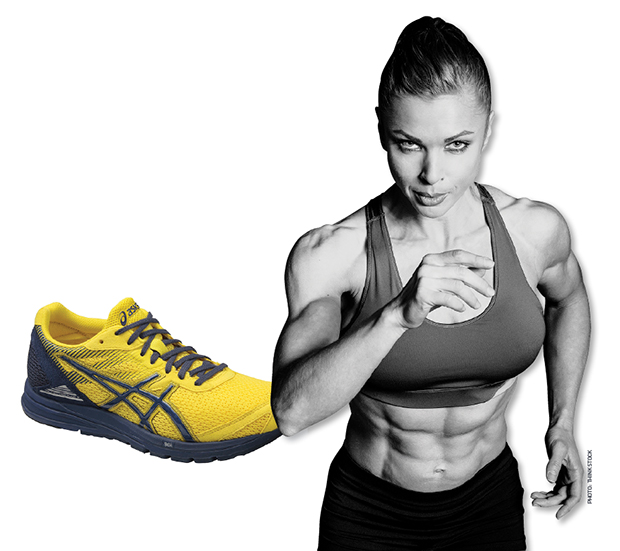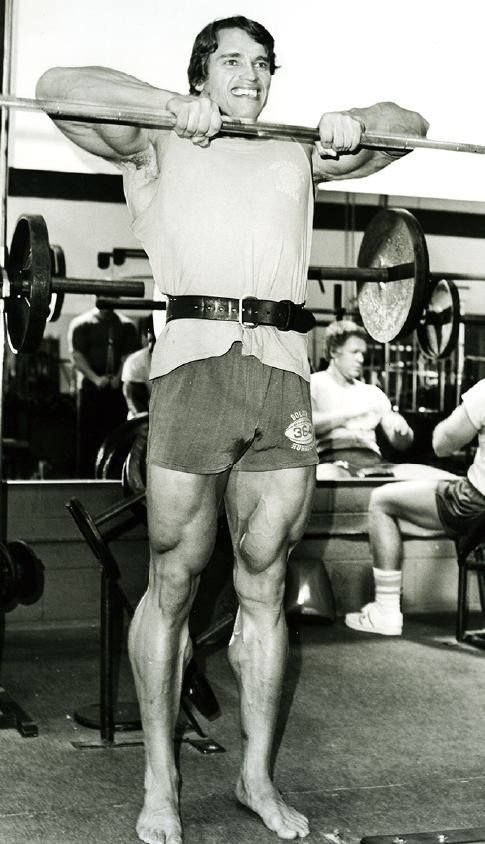If the Shoe Fits

Ask any powerlifter, bodybuilder, or CrossFit athlete about the equipment needed for their respective sport and they can likely rattle off a list of items. A lifting belt, straps, and knee and elbow wraps would probably top the lists, but what about their shoes? Are those typically considered a piece of equipment by many athletes? If they aren’t already, they should be!
Most athletes put a lot of thought into their footwear choice. Shoes need to fit comfortably, provide support, and (hopefully) look good. One thing seasoned athletes likely don’t think twice about is which shoes they need for their sport, but it’s something by which rookies might be confused.
Just as a sprinter wouldn’t wear soccer cleats to run the 100-meter dash, you shouldn’t wear running shoes if you’re looking to set a PR in a powerlifting meet. You need to select the appropriate shoes for the sport you’re competing in. The right shoe will provide the support and function needed for your activity of choice, which will enable you to perform your best and help prevent injuries.

Protect Your Feet
To understand why shoes are so important, you need to understand the body part they’re supporting—your feet. There are 26 bones in just one of your feet, making up almost a quarter of all the bones in your body! These bones are connected by 33 joints, and over a hundred muscles, tendons, and ligaments hold everything in place. Additionally, your feet are responsible for balance and mobility, and they’re also your conductor/connection to the floor for strength moves. Although your feet are strong on their own, they need the proper support for the tasks you put them through.
Not only can the right shoes help you perform at your optimal level, they can also decrease the likelihood of suffering some common injuries; stress fractures, bunions, and even strains to the calf muscles can all result from improper footwear. Injuries aren’t limited to the foot or lower leg region, though; improper footwear can cause issues all the way up your body. Shin splints, IT band syndrome, and back pain can all be traced back to the roots—your feet. Avoid the need to take time off from your sport because of an injury by paying attention to the function your shoes are built to perform.
Footwear Features
When shopping for new shoes, you might be confused by some of the terms used to explain the function of the shoe. These are some of the features of which you need to be aware:
- Flexibility: The ability for a shoe to bend (bring the toe to meet the heel), or twist (imagine wringing out the shoe). The flexibility of the shoe demonstrates how much structure there is in both the sole and the body of the shoe. The less flexible the shoe, the more rigid support it offers.
- Heel-toe drop: The thickness of the sole from the heel to the toe. Some shoes might have a heel a couple of inches higher than the toe (also known as the heel rise), while some shoes have a zero drop, making them flat.
- Weight: The total weight of the shoe. Lightweight, minimalist shoes can be as light as 5 ounces, while shoes with more structure and support can weigh up to almost 2 pounds.
- Stack height: The thickness of padding between your foot and the ground. Shoes may have a different stack height in the heel region versus the toe (giving it a heel-toe drop), but the stack height is the amount of material in the base of the shoe in total.
- Support: You might have heard the terms pronation and supination, which refer to the way the foot moves when it plants on the ground. Shoes are structured with different types of support to help correct unnecessary rolling, which can lead to ankle or knee injuries. Additionally, shoes can have different types of arch support to provide the stability you need.
Now that you’ve learned why footwear is important to your performance as an athlete and about the different features of shoes, we can dive into specific sports and which shoe works best for your sport of choice.

Powerlifting/Weight Lifting
The strength sport of powerlifting sees athletes compete across three different lifts: squat, bench press, and deadlift. The goal is simple: lift as much weight as you possibly can through a judged range of motion. In this sport there are two focuses—weight and form—with which powerlifting shoes are built to assist. Shoes that can help you nail your form and lift more? Is this a case where something sounds too good to be true?
Powerlifting shoes are structured with a raised heel (heel-toe drop) of anywhere between half an inch and almost two inches. This feature is there to assist the athlete with squat depth and form. By raising the heels, you’ll have improved ankle mobility and will be able to keep your torso more upright. A study found healthy, active males were able to maintain a more vertical position when wearing shoes designed for weightlifting than with traditional cross-training shoes. Assisting these positions can help decrease the likelihood of injuries occurring in the knees and lower back.
Additional support is added around the middle of the foot in the form of straps or Velcro. This feature provides a strong and consistent base for you to push from and can help eliminate lateral movements when under the weight of the bar.
You’ll find these shoes lack cushioning, and that’s on purpose. When lifting, you want a shoe that will help you use all the force you can produce, making their flat, firm surface a benefit when you’re going for that 1RM. Also, when getting under a bar loaded up with a couple hundred pounds, the last thing you want is for your feet to be shifting inside your shoe, trying to find the proper cushioning. The flat soles of these shoes essentially keep you grounded. While you won’t want to run any distance in them, you can definitely perform a great squat in them!
A word of caution: Although the raised heel can help with form and position, you never see elite athletes wearing these shoes in competition. The shoes can be a great tool for beginners or those struggling with their form, but once this has been mastered, you can likely transition to another flat-soled shoe. Why? It’s hypothesized that more elite athletes have mastered their technique without the use of these specialized shoes. It’s also advised not to wear the platform/Olympic lifting shoes for deadlifting.
Popular Powerlifting / Weight lifting Shoe Brands: Inov-8, Adidas, Pendlay, and Reebok

CrossFit
Crossfit athletes perform various exercises in training and competition, with elements taken from powerlifting, gymnastics, strongman, and Olympic weightlifting. These are commonly performed in a high-intensity interval fashion with cardio elements woven into the workout. This blend requires athletes to quickly switch their focus (and physical demands) from lifting to cardio. Herein lies the question: Should an athlete rely on traditional weightlifting shoes for the advantage in their lifts, or cross-trainers to keep them covered in all situations?
In 2011, Reebok became the first official CrossFit footwear and apparel sponsor, and also released the Nano, a shoe created specifically for CrossFit. These shoes addressed the issue of which function to attend to within the sport by bridging the gap between the various aspects and skill sets.
CrossFit shoes provide stability for lifting, cushion for sprinting, and support for jumping and landing. With a pair of CrossFit shoes, athletes can also feel confident that their feet will be protected from any rope work, box jumps, and toe-to-bars with the specialized toe-cage and more durable body. Advances have allowed the manufacturers to add cushioning to the forefoot for cardio work, more heel stabilization, and a wider toe box for overall stability.
Additional factors to consider when you’re shopping for a CrossFit shoe include breathability (for those hot days), low stack height and flexibility (for the ability to feel and respond to the ground), and, obviously, how well they fit your foot when performing a variety of movements (especially running).
Popular CrossFit Shoe Brands: Reebok, Nike, New Balance, and Inov-8

Cross-Trainers & Running Shoes
What about those athletes who don’t fall into a specific sport category? Those who go to the gym and do various activities including weight training, fitness classes, or even an outdoor run need a shoe that meets all their needs. Cross-trainers are designed to support a mix of activities, making them an economic choice.
Cross-trainers are different from running shoes. Although both offer a decent stack height and cushioning, cross-trainers feature more support for lateral movements, making them ideal for fitness classes or a pick-up game of basketball or ultimate Frisbee.
While these shoes may not be the best option for a particular sport, they’re likely a staple in everyone’s closet because of their comfort and flexibility for daily use.
Popular Cross-Training Shoe Brands: Avia, New Balance, Nike, Asics, and Adidas
On the other hand, running shoes serve a more specific purpose and are structured to do so. Generally speaking, running shoes have a firm, cupped heel and a flexible forefoot to support heel-toe running patterns and avoid calf strain. They have specialized cushioning throughout the sole to help prevent injuries when logging miles on the roads. Cushioning (stack height) is a main feature of running shoes, while aspects such as the heel-toe drop aren’t crucial to performance.
Avid runners will have to be aware of the arch support they need, as well as how much their feet pronate. Pronation refers to the movement of your foot as it strikes the ground—neutral, under-pronated, or over-pronated. These factors can be determined by a gain analysis, which can be performed at a store focused on running shoes.
Popular Running Shoe Brands: New Balance, Saucony, Asics, and Mizuno

Minimalist
While these aren’t sport-specific shoes per se, they definitely deserve to be covered as their popularity increased a few years ago. These shoes exploded onto the scene about a decade ago, and although sales have recently declined, many people still use them for certain activities and sports. The term “minimalist” has been applied to a vast spectrum of shoes, from Vibrams to Nike Frees. The differences between these two shoes are their stack height and cushioning; however, they’re both still minimalist. To help streamline this category, a group of researchers created a scale for shoes to be judged on using a points system—too many points and a shoe isn’t considered minimalist.
Minimalist shoes should be highly flexible, have a very low heel-toe drop, be lightweight, have a low stack height, and have no motion control or stability devices built into them. Basically, these shoes provide minimal interference with the foot’s natural movement and a very small barrier between the foot and the ground.
Athletes have used these shoes for various activities because of their ability to connect to the ground and allow their foot to react as naturally as possible. Compared to weight lifting and powerlifting-specific shoes, these also have a low stack height, which allows wearers to really feel the ground, but they don’t have a raised heel or any lateral support systems. As previously mentioned, the lack of a raised heel may not be a drawback to some seasoned athletes.

Finally, remember that everything is individualized. Read product reviews and ask fellow athletes what they wear and why they like them, but take it all with a grain of salt. What works for one person may not work for you. The top-selling brand may feel terrible to you. If you’re able to perform at your peak, feel comfortable, and are injury-free, you’ve found the right fit.
Key References:
Cressy E. Should you wear Olympic lifting shoes? Performance and Health. Available at http://www.ericcressey.com/should-you-wear-olympic-lifting-shoes. Published June 3, 2014. Accessed January 1, 2016.
Esculier JF, Dubois B, Dionne CE, Leblond J, Roy JS. A consensus definition and rating scale for minimalist shoes. J Foot Ankle Res. 2015 Aug 19;8:42.
Fortenbaugh D, Sato, K, Hitt, JK. The effects of weightlifting shoes on squat kinematics. International Symposium on Biomechanics in Sports: Conference. 2010;21
Shoes aren't the only piece of the puzzle; orthotics are important too! Check out an article by Dr. Ken Kinakin about the importance of putting orthotics in your shoes!

